Assessment and Mitigation of Fecal Bacteria Exports from a Coastal North Carolina Watershed
Abstract
:1. Introduction
2. Materials and Methods
2.1. Site Selection
2.2. Sampling Locations
2.3. Physicochemical Characteristics of Waters
2.4. Fecal Indicator Bacteria Enumeration and Exports
2.5. Determination of FIB Source
2.6. Stormflow and Baseflow FIB Concentrations and Exports
2.7. FIB Concentrations during Warm and Cold Months
2.8. Stormwater Control Measure Implementation
3. Results and Discussion
3.1. Fecal Indicator Bacteria Concentrations
3.2. Spatial Variability in FIB Concentrations
3.3. Temporal Variability in FIB Concentrations and Loadings
3.4. Physicochemical Characteristics
3.5. Stormwater Control Measure Runoff Reductions
4. Conclusions
Supplementary Materials
Author Contributions
Funding
Data Availability Statement
Acknowledgments
Conflicts of Interest
References
- Li, D.; Liu, M.; Hu, Y.; Shi, T.; Qu, X.; Walter, M.T. Effects of urbanization on direct characteristics in urban functional zones. Sci. Total Environ. 2018, 643, 301–311. [Google Scholar] [CrossRef] [PubMed]
- Maniquiz-Redillas, M.; Robles, M.E.; Cruz, G.; Reyes, N.J.; Kim, L.-H. First flush stormwater runoff in urban catchments: A bibliometric and comprehensive review. Hydrology 2022, 9, 63. [Google Scholar] [CrossRef]
- Chen, J.; Theller, L.; Gitau, M.W.; Engel, B.A.; Harbor, J.M. Urbanization impacts on surface runoff of the contiguous United States. J. Environ. Manag. 2017, 187, 470–481. [Google Scholar] [CrossRef] [PubMed]
- Hardison, E.C.; O’Driscoll, M.A.; DeLoatch, J.P.; Howard, R.J.; Brinson, M.M. Urban land use, channel incision, and water table decline along coastal plain streams, North Carolina. J. Am. Water Resour. Assoc. 2009, 45, 1032–1046. [Google Scholar] [CrossRef]
- Manda, A.K.; Sisco, M.S.; Mallinson, D.J.; Griffin, M.T. Relative role and extent of marine and groundwater inundation on a dune-dominated barrier island under sea-level rise scenarios. Hydrol. Process. 2015, 29, 1894–1904. [Google Scholar] [CrossRef]
- Wurster, S.; Paraskevopoulos, T.; Toda, M.; Jiang, Y.; Tarrand, J.T.; Williams, S.; Chiller, T.M.; Jackson, B.R.; Kontoyiannis, D.P. Invasive mould infections in patients from floodwater-damaged areas after hurricane Harvey- a closer look at an immunocompromised cancer patient population. J. Infect. 2022, 84, 701–709. [Google Scholar] [CrossRef]
- Soetanto, R.; Proverbs, D.G. Impacts of flood characteristics on damage caused to UK domestic properties: The perceptions of building surveyors. Struct. Surv. 2004, 22, 95–104. [Google Scholar] [CrossRef] [Green Version]
- Collins, K.A.; Lawrence, T.J.; Stander, E.K.; Jontos, R.J.; Kaushal, S.S.; Newcomer, T.A.; Grimm, N.B.; Ekberg, M.L.C. Opportunities and challenges for managing nitrogen in urban stormwater: A review and synthesis. Ecol. Eng. 2010, 36, 1507–1519. [Google Scholar] [CrossRef]
- Cahoon, L.B.; Hales, J.C.; Carey, E.S.; Loucaides, S.; Rowland, K.R.; Nearhoof, J.E. Shellfishing closures in Southwest Brunswick County, North Carolina: Septic tanks vs. storm-water runoff as fecal coliform sources. J. Coast. Res. 2006, 22, 319–327. [Google Scholar] [CrossRef]
- Dietz, M.E. Low impact development practices: A review of current research and recommendations for future directions. Water Air Soil Pollut. 2007, 186, 351–363. [Google Scholar] [CrossRef]
- Humphrey, C.P.; Iverson, G. Reduction in nitrogen exports from stormflow after conversion of a dry detention basin to a stormwater wetland. Appl. Sci. 2020, 10, 9024. [Google Scholar] [CrossRef]
- Humphrey, C.P.; Ivreson, G.; Nolan, M. Nitrogen treatment by a dry detention basin with stormwater wetland characteristics. Hydrology 2022, 9, 85. [Google Scholar] [CrossRef]
- Vietz, G.J.; Walsh, C.J.; Fletcher, T.D. Urban hydrogeomorphology and the urban stream syndrome: Treating the symptoms and causes of geomorphic change. Prog. Phys. Geogr. 2016, 40, 480–492. [Google Scholar] [CrossRef]
- Newburn, D.A.; Alberini, A. Household response to environmental incentives for rain garden adoption. Water Resour. Res. 2016, 52, 1345–1357. [Google Scholar] [CrossRef] [Green Version]
- Bastia, J.; Mishra, B.K.; Kumar, P. Integrative assessment of stormwater infiltration practices in rapidly urbanizing cities: A case of Lucknow City, India. Hydrology 2021, 8, 93. [Google Scholar] [CrossRef]
- National Oceanic and Atmospheric Administration Department. National Coastal Population Report, Population Trends from 1970–2020. Available online: https://coast.noaa.gov/digitalcoast/training/population-report.html (accessed on 22 July 2023).
- NC Department of Environmental Quality. Basin Planning Branch 2023. Available online: https://www.deq.nc.gov/about/divisions/water-resources/water-planning/basin-planning-branch (accessed on 22 July 2023).
- NC Department of Environmental Quality. White Oak Basin Plan. 2007. Available online: https://www.deq.nc.gov/about/divisions/water-resources/water-planning/basin-planning/river-basin-plans/white-oak#2007WhiteOakBasinPlan-4044 (accessed on 22 July 2023).
- Gotkowksa-Plachta, A.; Goals, I.; Korzeniewaka, E.; Koc, J.; Rochwerger, A.; Solarski, K. Evaluation of the distribution of fecal indicator bacteria in a river system depending on different types of land use in the southern watershed of the Baltic Sea. Environ. Sci. Pollut. Res. 2016, 23, 4073–4085. [Google Scholar] [CrossRef]
- Kon, T.; Weir, S.C.; Howell, E.T.; Lee, H.; Trevors, J.T. Repetitive element (REP)-polymerase chain reaction (PCR) analysis of Escherichia coli isolates from recreational waters of southeastern Lake Huron. Can. J. Microbiol. 2009, 55, 269–276. [Google Scholar] [CrossRef]
- Wright, M.E.; Solo-Gabriele, H.M.; Elmir, S.; Fleming, L.E. Microbial load from animal feces at a recreational beach. Marine Pollut. Bull. 2009, 58, 1649–1656. [Google Scholar] [CrossRef] [Green Version]
- Nguyen, K.H.; Senay, C.; Young, S.; Nayak, B.; Lobos, A.; Conrad, J.; Harwood, V.J. Determination of wild animal sources of fecal indicator bacteria by microbial source tracking (MST) influences regulatory decisions. Water Res. 2018, 144, 424–434. [Google Scholar] [CrossRef]
- Toledo-Hernandez, C.; Ryu, H.; Gonzalez-Nieves, J.; Huertas, E.; Toranzos, G.A.; Domingo, J.W.S. Tracking the primary sources of fecal pollution in a tropical watershed in a one-year study. Appl. Environ. Microbiol. 2013, 79, 1689–1696. [Google Scholar] [CrossRef] [Green Version]
- Humphrey, C.; Finley, A.; O’Driscoll, M.; Manda, A.; Iverson, G. Groundwater and stream E. coli concentrations in coastal plain watersheds served by onsite wastewater and a municipal sewer treatment system. Water Sci. Technol. 2015, 72, 1851–1860. [Google Scholar] [CrossRef] [PubMed]
- Humphrey, C.P., Jr.; Sanderford, C.; Iverson, G. Concentrations and exports of fecal indicator bacteria in watersheds with varying densities of onsite wastewater systems. Water Air Soil Pollut. 2018, 229, 277. [Google Scholar] [CrossRef]
- Iverson, G.; Sanderford, C.; Humphrey, C.P., Jr.; Etheridge, J.R.; Kelley, T. Fecal indicator bacteria transport from watersheds with differing wastewater technologies and septic system densities. Appl. Sci. 2020, 10, 6525. [Google Scholar] [CrossRef]
- Mallin, M.A.; Williams, K.E.; Esham, E.C.; Lowe, R.P. Effect of human development on bacteriological water quality in coastal watersheds. Ecol. Appl. 2000, 10, 1047–1056. [Google Scholar] [CrossRef]
- Mallin, M.A.; Johnson, V.L.; Ensign, S.H. Comparative impacts of stormwater runoff on water quality of an urban, suburban, and a rural stream. Environ. Monit Assess 2009, 159, 475–491. [Google Scholar] [CrossRef] [PubMed]
- United States Forest Service. Croatan National Forest. Available online: https://www.fs.usda.gov/recarea/nfsnc/recarea/?recid=48466 (accessed on 22 July 2023).
- Cedar Point, North Carolina Population History. Available online: https://www.biggestuscities.com/city/cedar-point-north-carolina (accessed on 22 July 2023).
- Weather Spark. Climate and Average Weather Year round in Newport, NC. Available online: https://weatherspark.com/y/21630/Average-Weather-in-Newport-North-Carolina-United-States-Year-Round (accessed on 22 July 2023).
- United States Environmental Protection Agency. 2012 Recreational Water Quality Criteria. Office of Water EPA-820-F-12-061. Available online: https://www.epa.gov/sites/default/files/2015-09/documents/npdes-water-quality-based-permit-limits-for-recreational-water-quality-criteria-faqs_0.pdf (accessed on 22 July 2023).
- North Carolina Department of Environmental Quality, Stormwater Calculations. Available online: https://files.nc.gov/ncdeq/Energy%20Mineral%20and%20Land%20Resources/Stormwater/BMP%20Manual/B%20%20Stormwater%20Calculations.pdf (accessed on 2 June 2023).
- Osmond, D.L.; Gilliam, J.W.; Evans, R.O. Riparian Buffers and Controlled Drainage to Reduce Agricultural Nonpoint Source Pollution. NC Agricultural Research Ser-vice Technical Bulletin 318, North Carolina State University, Raleigh, NC. Available online: https://content.ces.ncsu.edu/riparian-buffers-and-controlled-drainage-to-reduce-agricultural-nonpoint-source-pollution (accessed on 22 July 2023).
- Winston, R.J.; Powell, J.T.; Hunt, W.F. Retrofitting a grass swale with rock check dams: Hydrologic impacts. Urban Water J. 2019, 16, 404–411. [Google Scholar] [CrossRef]
- Knight, E.M.P.; Hunt, W.F.; Winston, R.J. Side-by-Side Evaluation of Four Level Spreader-Vegetated Filter Strips and a Swale in Eastern North Carolina. J. Soil Water Conserv. 2013, 68, 60–72. [Google Scholar] [CrossRef]
- Bäckström, M. Grassed Swales for Stormwater Pollution Control during Rain and Snowmelt. Water Sci. Technol. 2003, 48, 123–132. [Google Scholar] [CrossRef]
- Stall, C.; Amoozegar, A.; Graves, A.; Rashash, D. Transport of E. coli in a sandy soil as impacted by depth to water table. J. Environ. Health 2014, 76, 92–100. [Google Scholar]
- Pachepsky, Y.A.; Shelton, D.R. Escherichia coli and fecal coliforms in freshwater and estuarine sediments. Crit. Rev. Environ. Sci. Technol. 2011, 41, 1067–1110. [Google Scholar] [CrossRef]
- Thompson, M.; Milbrandt, E.; Bartleson, R.; Rybak, A. Evaluation of bacteriological and nutrient concerns in nearshore waters of a barrier island community in SW Florida. Mar. Pollut. Bull. 2012, 64, 1425–1434. [Google Scholar] [CrossRef] [PubMed]
- Harwood, V.J.; Whitlock, J.; Withington, V. Classification of antibiotic resistance patterns of indicator bacteria by discriminant analysis: Use of predicting the source of fecal contamination in subtropical waters. Appl. Environ. Microbiol. 2000, 66, 3698–3704. [Google Scholar] [CrossRef] [PubMed] [Green Version]
- Hathaway, J.M.; Hunt, W.F.; Simmons III, O.D. Statistical evaluation of factors affecting indicator bacteria in urban storm-water runoff. J. Environ. Eng. 2010, 136, 1360–1368. [Google Scholar] [CrossRef]
- United States Department of Agriculture, Natural Resources Conservation Service. Official Soil Series Description. Available online: https://soilseries.sc.egov.usda.gov/osdname.aspx (accessed on 22 July 2023).
- NC Department of Environmental Quality. White Oak Plan 2021. Available online: https://www.deq.nc.gov/about/divisions/water-resources/water-planning/basin-planning/river-basin-plans/white-oak#2021WhiteOakBasinPlan-9661 (accessed on 22 July 2023).
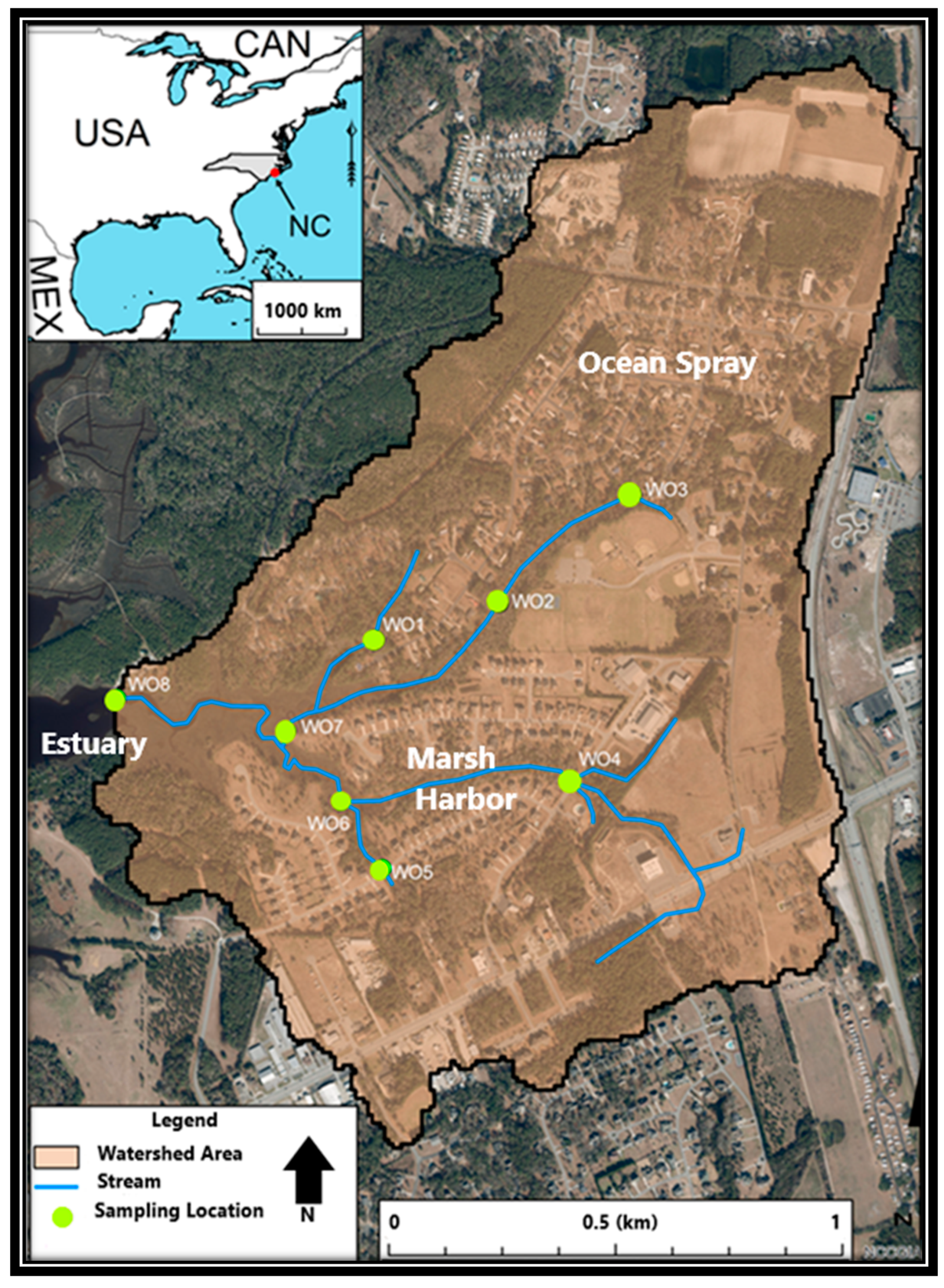
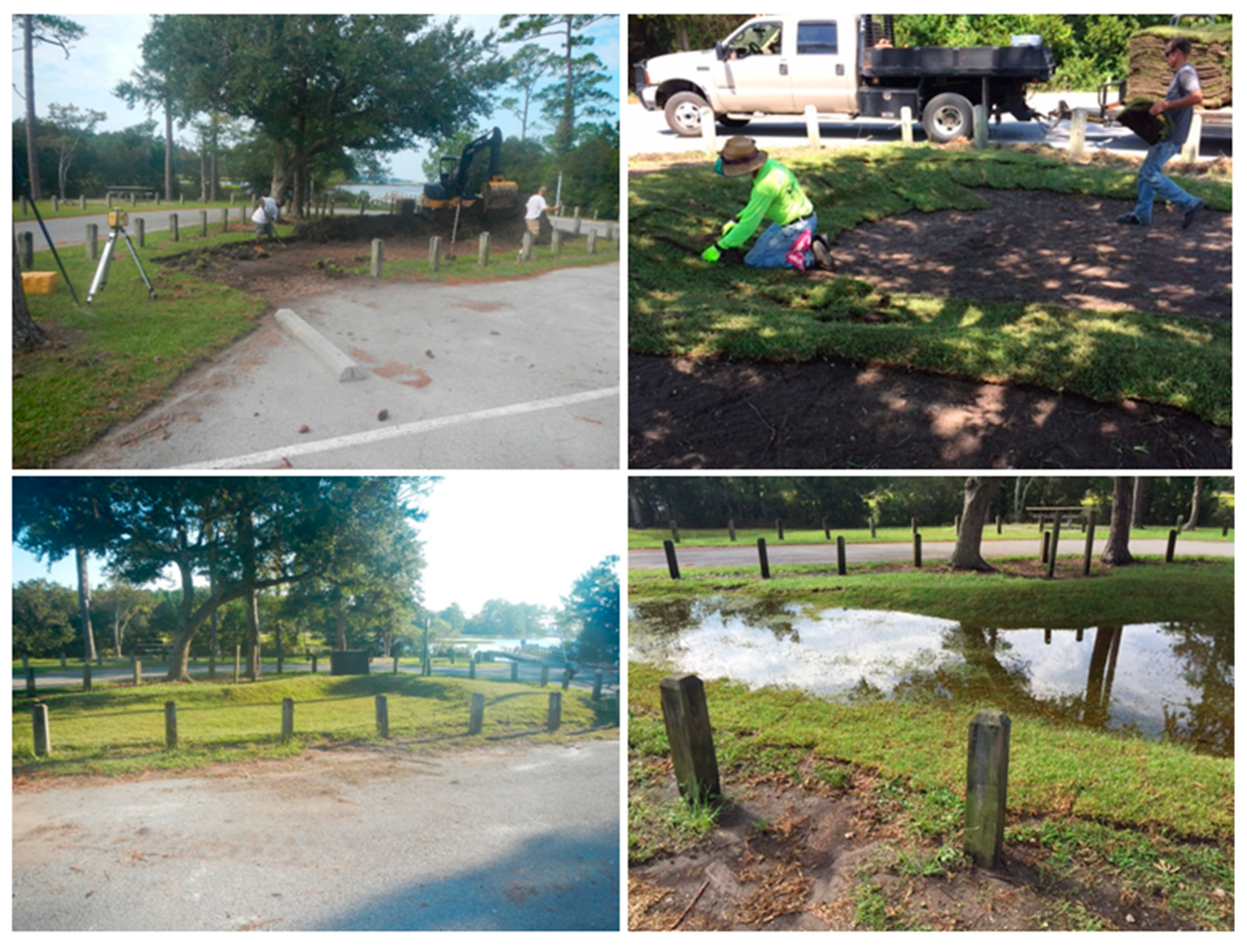
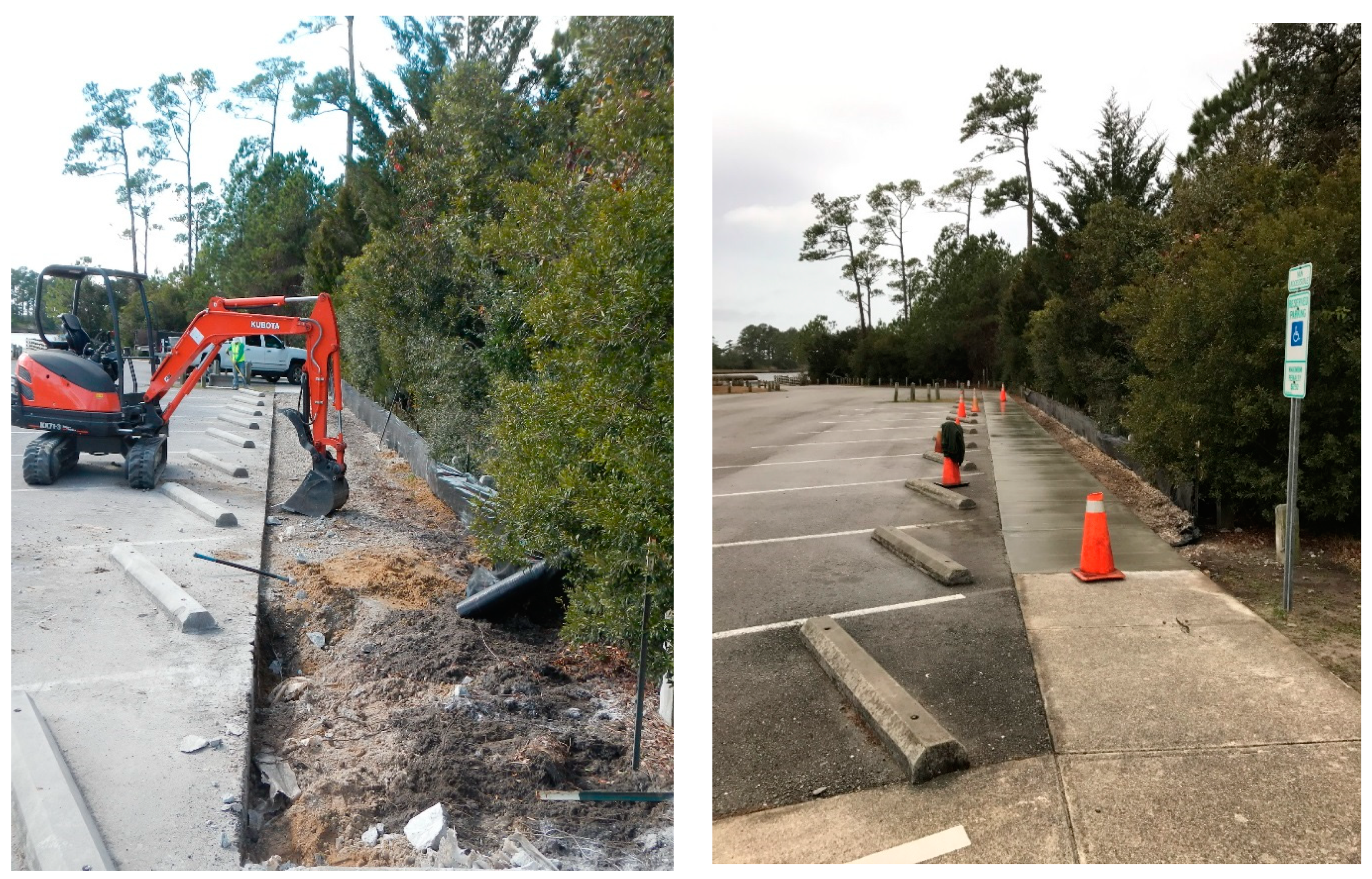
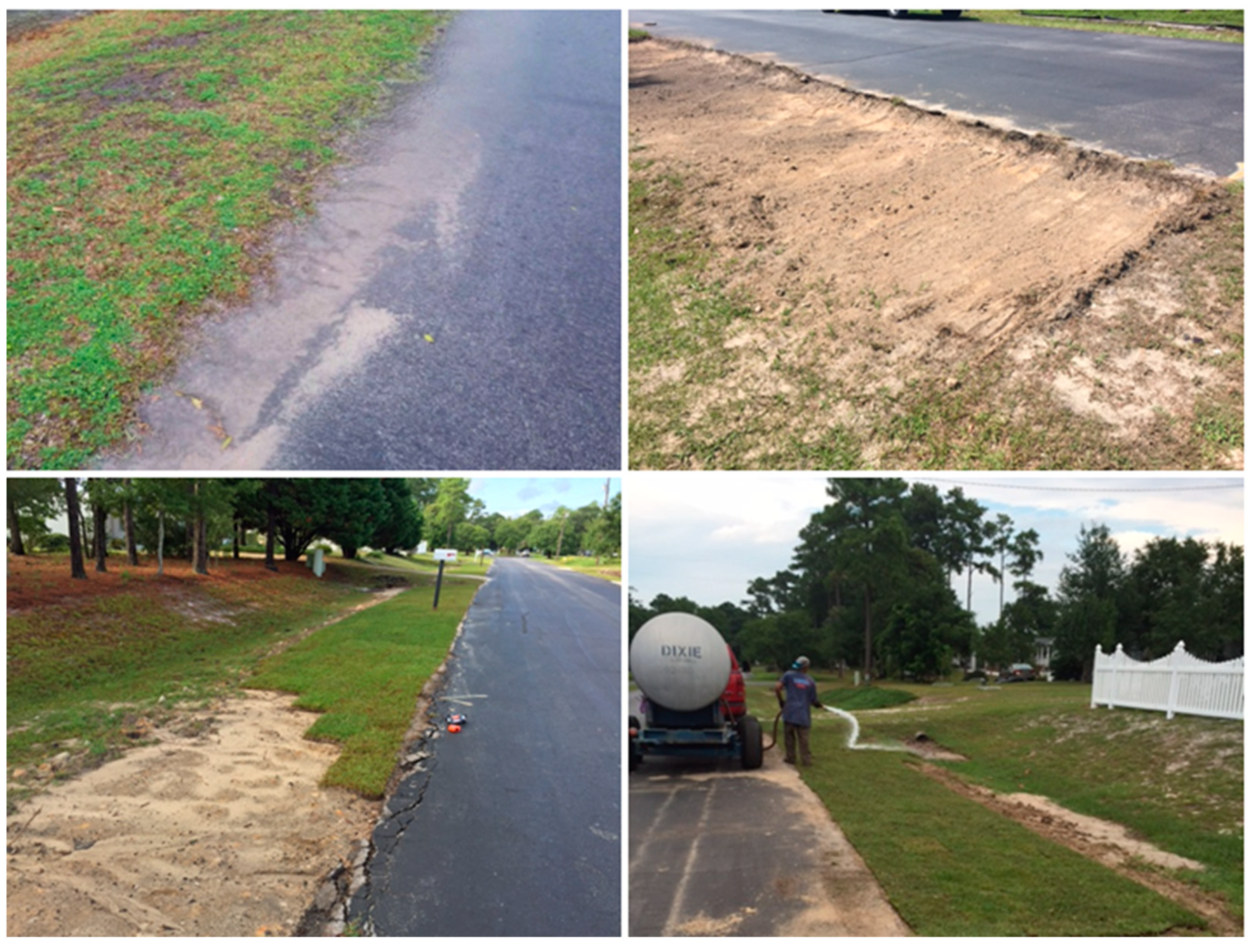

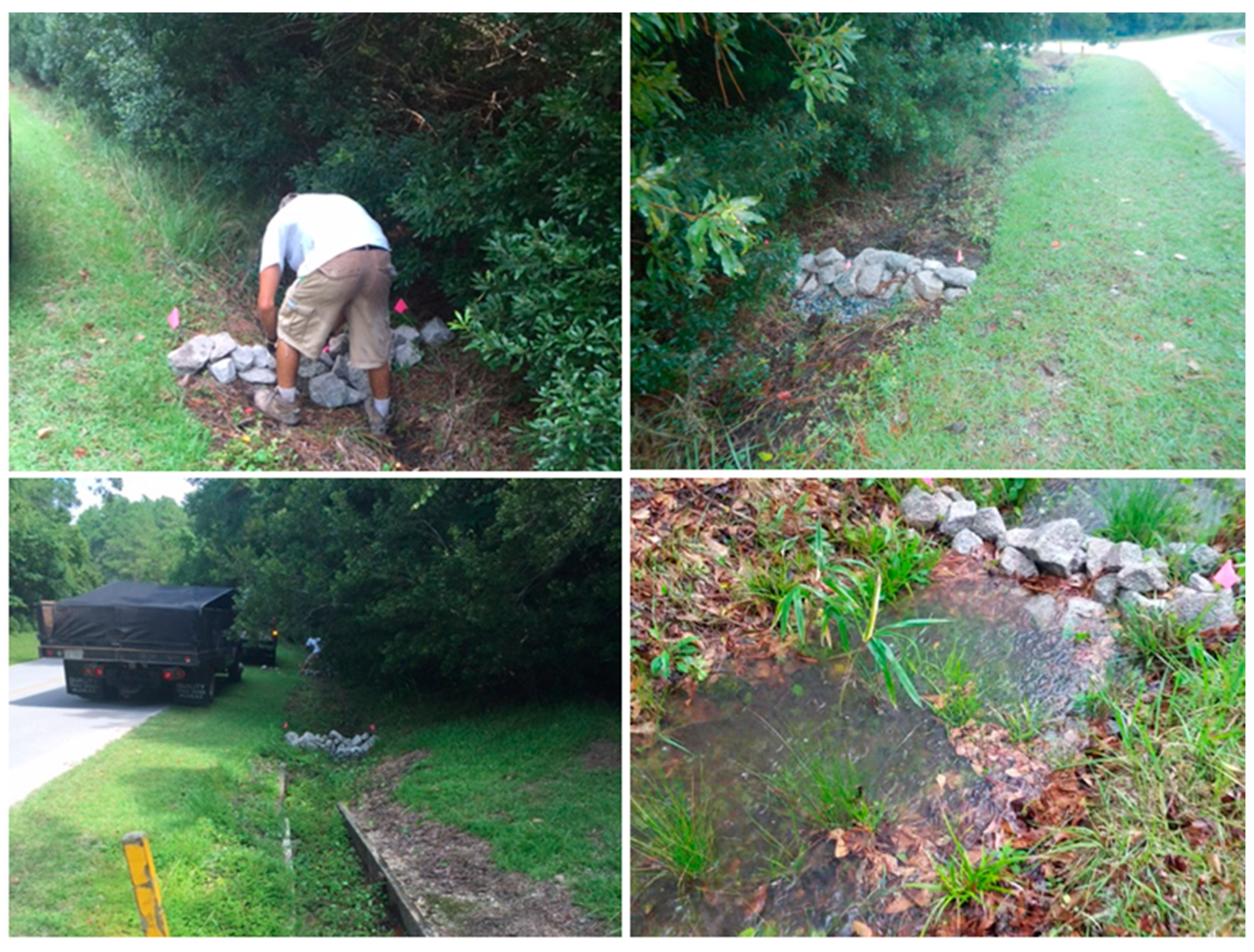

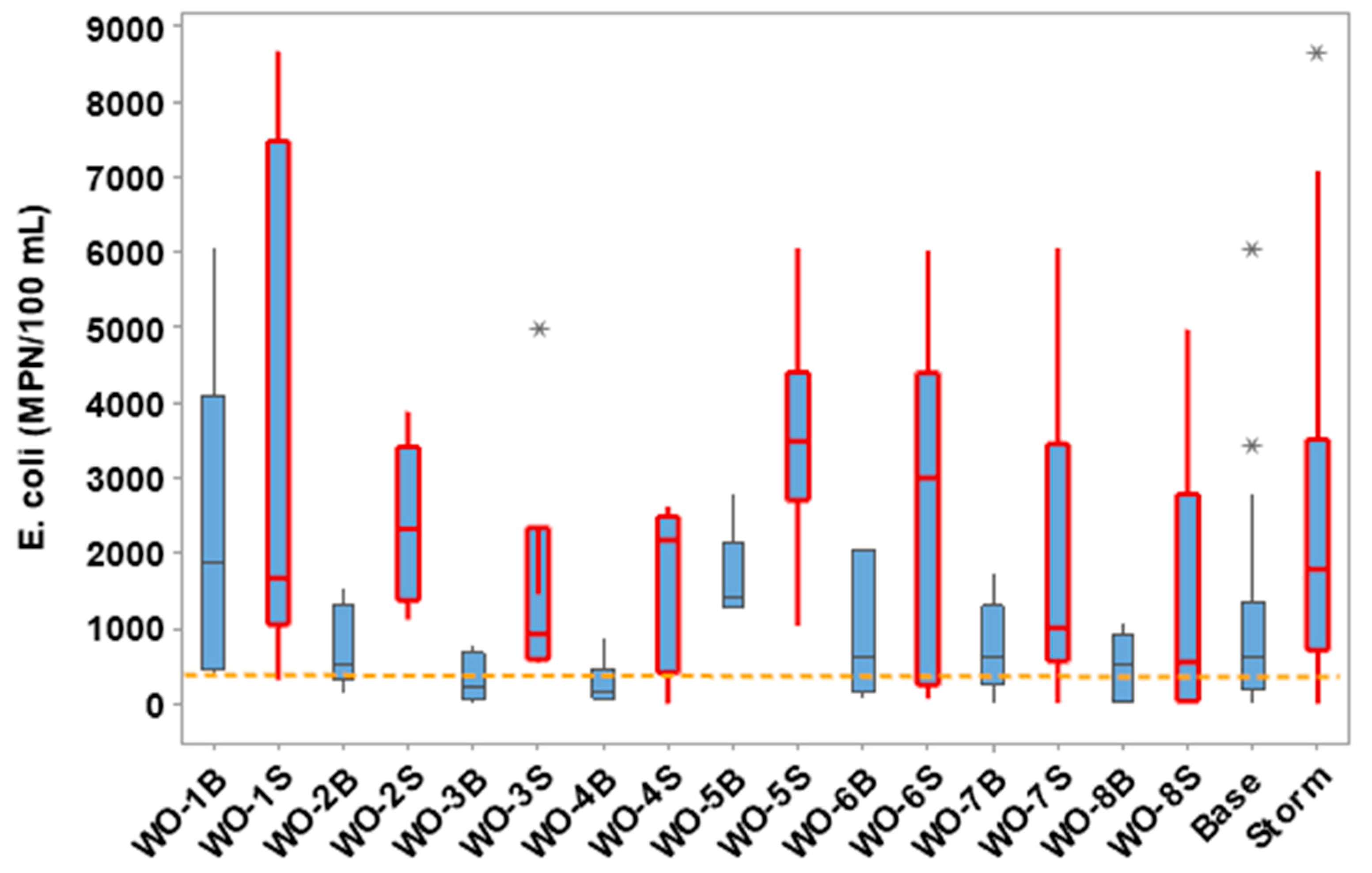
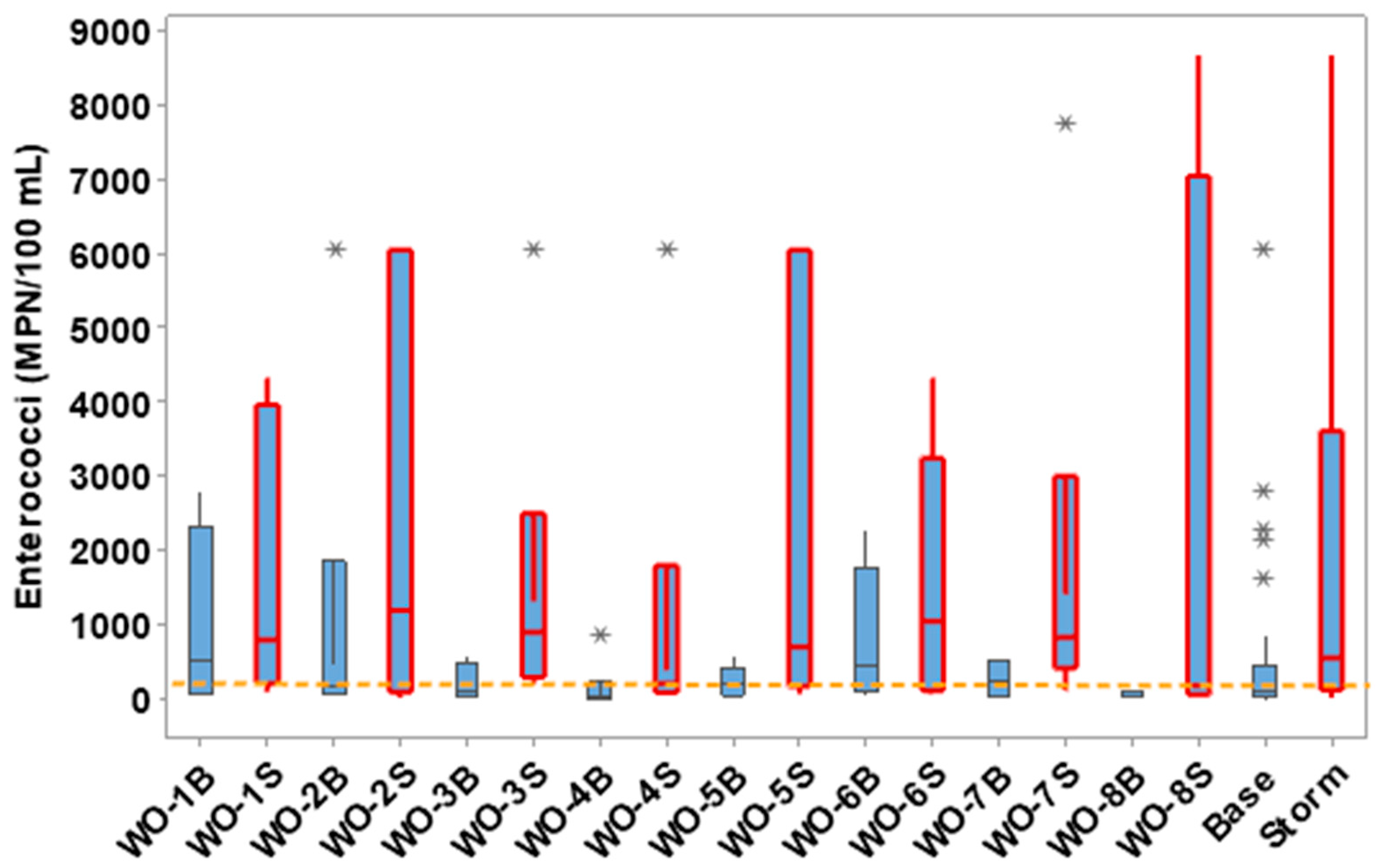

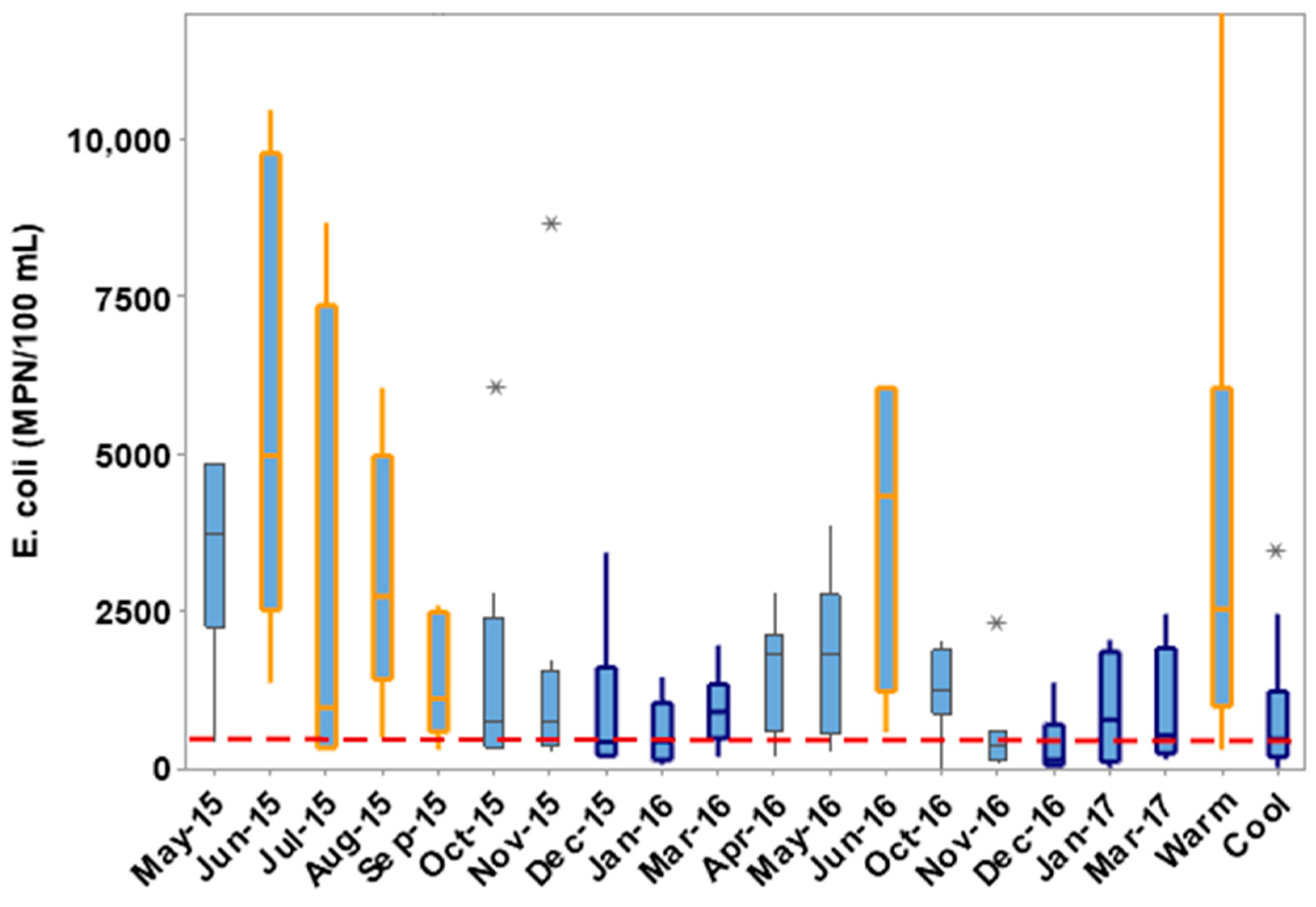
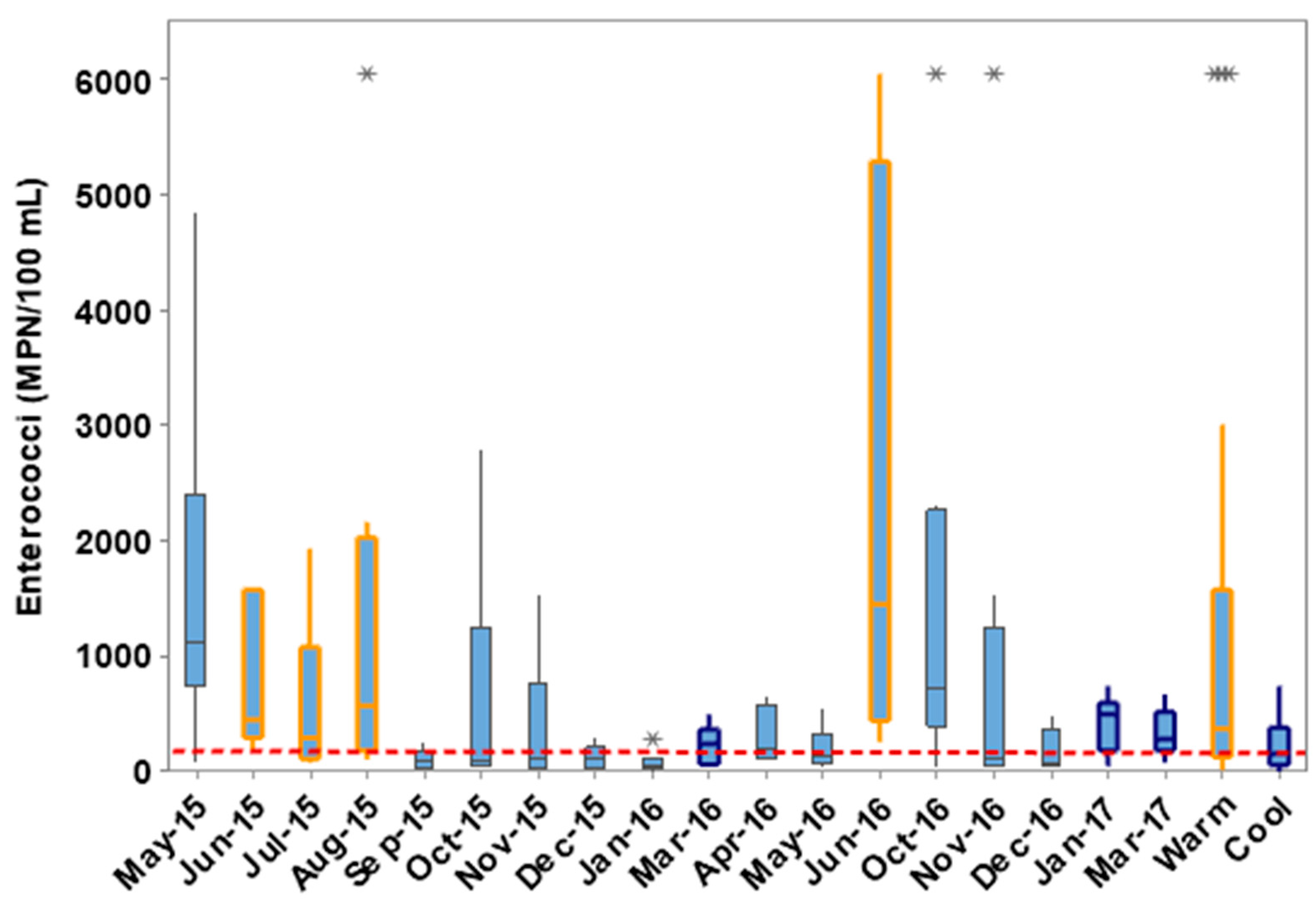
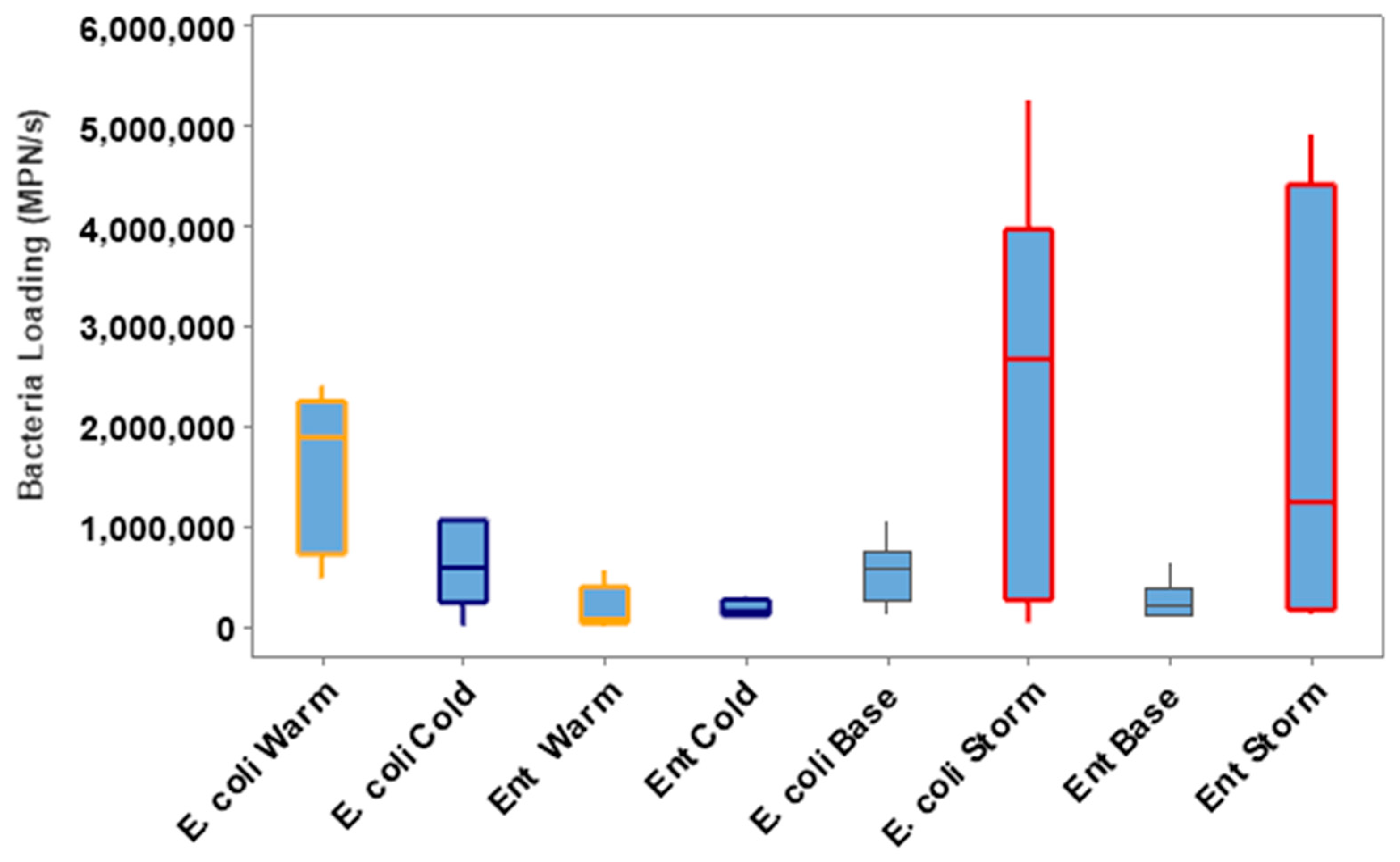
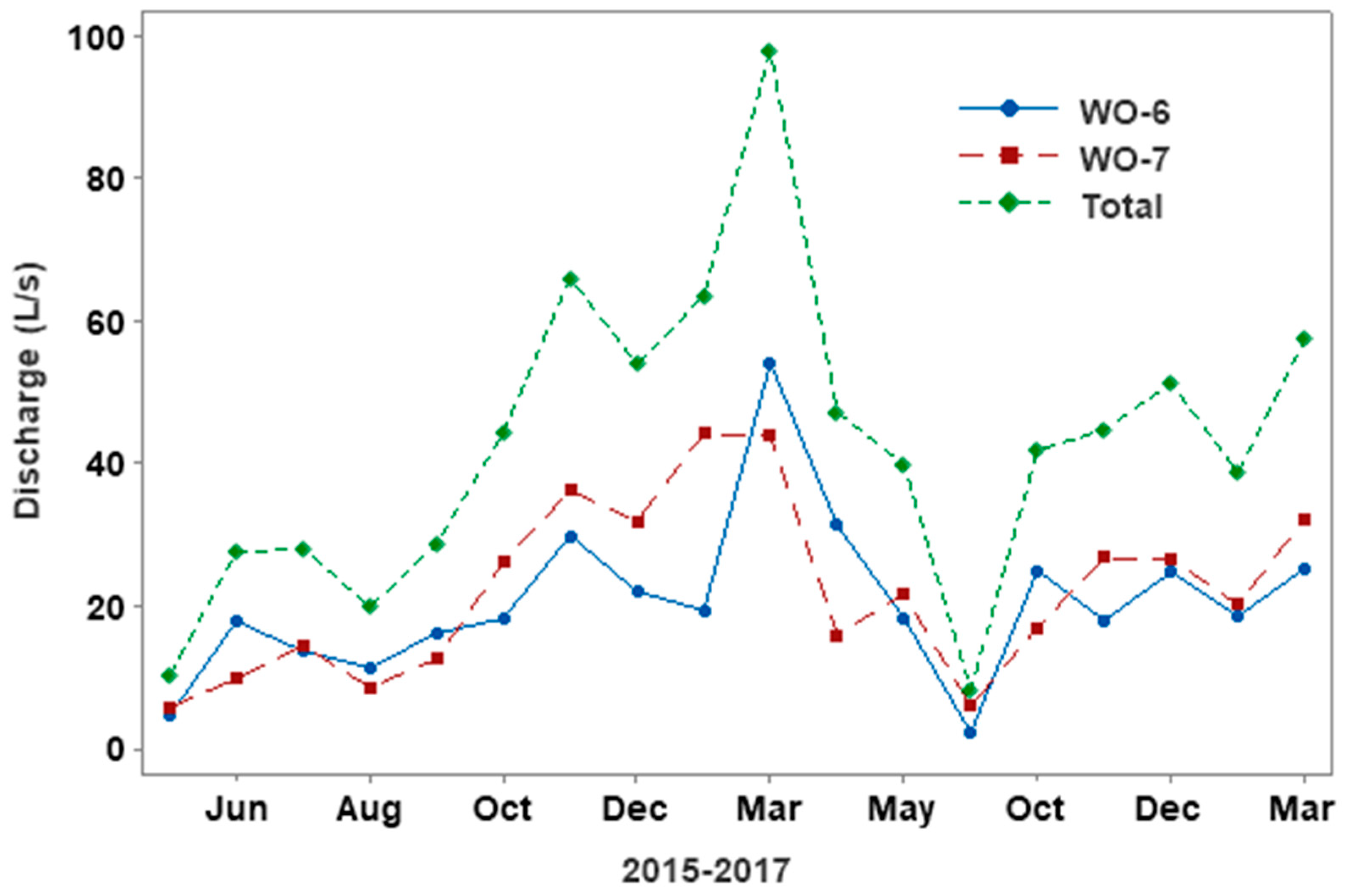
| Map Unit Symbol | Map Unit Name | Hydrologic Soil Group | Acres | Percent Area |
|---|---|---|---|---|
| Ag | Augusta loamy fine sand | B/D | 2.7 | 0.4% |
| Ap | Arapahoe fine sandy loam | A/D | 44.1 | 7.0% |
| ByB | Baymeade fine sand | A | 52.8 | 8.4% |
| HB | Hobucken mucky fine sandy loam | B/D | 26.0 | 4.2% |
| KuB | Kureb sand | A | 88.4 | 14.1% |
| Ln | Leon sand | A/D | 86.9 | 13.9% |
| Se | Seabrook fine sand | A | 61.6 | 9.8% |
| WaB | Wando fine sand | A | 252.9 | 40.5% |
| W | Water | 10.3 | 1.7% | |
| Total | 625.7 | 100.0% |
| Control Measure | Drainage Area (m2) | Impervious Surface (m2) | Annual Rain Depth (m) | Pre-SCM Runoff Volume (m3) | Post-SCM Runoff Volume (m3) |
|---|---|---|---|---|---|
| WCS-1 | 10926.5 | 2428.1 | 1.25 | 3686 | 1253 |
| WCS-2 | 6070.3 | 1335.5 | 1.25 | 1909 | 649 |
| WCS-3 | 1618.7 | 445.2 | 1.25 | 611 | 208 |
| WCS-4 | 1214.1 | 242.8 | 1.25 | 354 | 120 |
| WCS-5 | 1214.1 | 283.3 | 1.25 | 400 | 136 |
| Rain Garden | 748.7 | 218.5 | 1.25 | 297 | 0 |
| Walkway | 473.5 | 473.5 | 1.25 | 570 | 0 |
| Check Dams | 509.9 | 352.1 | 1.25 | 434 | 148 |
| Totals | 22775.8 | 5779 | 8261 | 2514 |
Disclaimer/Publisher’s Note: The statements, opinions and data contained in all publications are solely those of the individual author(s) and contributor(s) and not of MDPI and/or the editor(s). MDPI and/or the editor(s) disclaim responsibility for any injury to people or property resulting from any ideas, methods, instructions or products referred to in the content. |
© 2023 by the authors. Licensee MDPI, Basel, Switzerland. This article is an open access article distributed under the terms and conditions of the Creative Commons Attribution (CC BY) license (https://creativecommons.org/licenses/by/4.0/).
Share and Cite
Humphrey, C.P., Jr.; Lyons, N.; Bond, R.; Bean, E.; O’Driscoll, M.; White, A. Assessment and Mitigation of Fecal Bacteria Exports from a Coastal North Carolina Watershed. Hydrology 2023, 10, 156. https://doi.org/10.3390/hydrology10070156
Humphrey CP Jr., Lyons N, Bond R, Bean E, O’Driscoll M, White A. Assessment and Mitigation of Fecal Bacteria Exports from a Coastal North Carolina Watershed. Hydrology. 2023; 10(7):156. https://doi.org/10.3390/hydrology10070156
Chicago/Turabian StyleHumphrey, Charles P., Jr., Nicole Lyons, Ryan Bond, Eban Bean, Michael O’Driscoll, and Avian White. 2023. "Assessment and Mitigation of Fecal Bacteria Exports from a Coastal North Carolina Watershed" Hydrology 10, no. 7: 156. https://doi.org/10.3390/hydrology10070156






